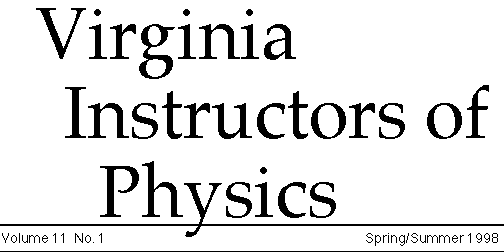
Dear Physics or Physical Science Teacher;
This letter has two purposes. The first is to let you know of a free
organization run by teachers for teachers, the Virginia Instructors
of Physics. Don't be fooled by the name. We are for teachers of
physics and physical science. Secondly, to recruit you to receive or
to continue to receive our newsletter. It seems that many individuals
have moved around and the addresses we have are no longer
correct.
The Virginia Instructors of Physics, V.I.P., was formed 11 years ago.
At the time its endeavors we supported both financially and
organizationally by James Madison University's Physics Department.
They maintained the mailing list and footed the bill for copying a
newsletter and mailing it. Physics and physical science teachers got
together and agreed to create some method of keeping in touch. We
adopted a constitution about 7 years ago. VIP's mission is to
foster communication among teachers of physics and physical science
as well as to provide unique learning experiences for teachers and
their students.
Currently we co-sponsor the state wide Physics Olympics
held at Paramount's Kings Dominion in Doswell, VA. We also over see
an a Physics web site in Virginia on Virginia's Public Education
Network. Through the sponsorship of the University of Virginia's
Physics Department we send out a multi page newsletter about 3 times a year. We hold meetings 2 times a year in
the fall and spring. The the University of Virginia hosts/sponsors
one of these meetings annually. We move the other meeting around with
the Virginia Association of Science Teachers' conference. Our mailing
list currently contains about 225 members. Membership is free. The spring meeting is free. All officers
and other involved persons volunteer their time.
If you receive our newsletter and wish to continue please
mail or e-mail a note to me. If you wish to join our group, please
mail or e-mail a note to me at the address located at the end of this
message. Mail us your school address
please .
If there are any questions I can answer, please let me know.
Sincerely,
Tony Wayne
VIP President
HURRY next meeting is
coming VERY FAST!!!
The next meeting is April 25th,
1998, at the University of Virginia.
The meeting is free to everyone! There will be a raffle for a
commercial water rocket launcher. The launcher sold for over $100.
Okay... we got it slightly used. It was a prototype. But it looks
great! There will be many, many, many other freebies. It is worth the
trip!!!
Agenda:
9:00 -9:30 Hello's with coffee and sweets
9:30-10:30 VIP business: Elect a new president, update on the web
site, VIP furture.
10:30 -12:00 Begin sharing with other teachers.
12:00 - 1:30 Lunch (Bring your own or money to buy.)
1:30 - 3:30 More sharing. (Let us know ahead of time if you need
an overhead or anything else.
NOTES:
Come ready to share stuff.
Bring a lab or a demo to share with others. We have had some great
demo's i the past. (Bring 35 copies to share.)
The state seems to want more graphing calculator stuff -bring a
calculator tip or a lesson to share. Have you written any great
program for the graphing calculator. Bring them on disk or on your
calculator to share with everyone.
Bring a diskette of shareware that you use. We will put it up on the
web site or give it away to people who bring a blank disk.
Bring a list of resources.
This promises to be another terrific meeting with lots to share and
lots to take home!
Click here to send registration
e-mail to Tony Wayne.
A Note from the
President
The time has come for me to step down. Often, a physics teacher may
be the only physics teacher in their schoool and sometimes in their
county. VIP was formed some 10 years ago to provide a means to end
the alienation some physics and physical science teachers have felt.
I've been VIP's president and newsleter writer for a few years now.
But this year I have been unable to get things together. My school's
transition payment plan and my family life have dominated my time.
This is why I'm stepping down as president and newsletter
writer/collector. The state likes the physics pavillion and this
merges with some of my other responsibilities. I'll keep volunteering
to keep up the site.
At the Spring meeting the following handout on
vactors was given.
Bomb Disposal Duty
Your world renown lab group has been recruited by the CIA to assist
with the disarmament of a large thermonuclear device located under
the tomb of an unidentified confederate officer in downtown. The
cover plate for the bomb is an rectangle the exact size and shape of
your lab table). Our agents have obtained (from a spy masquerading as
the HS principal) a complex vector description of the only place on
the cover plate that a hole can be safely drilled to allow the
disarmament of the bomb. You have 40 minutes from the time you begin
reading this to locate this spot, and mark it with a piece of chalk.
Then notify "the chief."
Your grade on this project depends on the accuracy of your spot
location. However, if you fail to locate a spot before time expires,
you will get a zero ! ! ! The only materials you will be allowed for
this lab are your calculators and the materials provided at your lab
station. If you finish early, redo your calculations and check your
answer. You must clean your lab table before you leave class. In
order to receive full credit, you must register by putting your lab
group's name on the back board prior to starting the lab.
Spot location:
From the x on the center of the cover plate: Go 5.00 inches due
south; go 0.00152 furlongs east; go 0.000249 miles in a direction 45
degrees north of west; go 10.0 cm in a direction 45 degrees south of
east; rotate 115 degrees clockwise from the last vector direction and
travel 500,000,700 nm; go 0.100 feet west; go 1.76 yards in a
direction 67.0 degrees east of south; go 0.500 fathoms in a direction
20 degrees north of west; go 0.708 meters in a direction 79.0 degrees
east of north.
You may now drill safely!
880 fathoms= 1 mile I furlong = 7920 inches
Bomb Disposal Lab
by E.O. Curry, O'Fallon Township High School], O'Fallon, IL
Submitted by: Richard Lahti Craig Co. High School, Newcastle, VA
Primary Objectives: For students to practice vector addition and
conversion factors. Secondary objectives: Teamwork, following
directions
I use this lab early in the year, as I first teach conversion
factors, significant digits, scientific notation and then vectors.
Vectors are something that students have some difficulty with, it is
'hard" topic, it is mathematical (which is a real problem ,with some
of my math phobic students) and lets face it, isolated vector
problems really aren't much fun. The idea of this lab is to put
conversion factors and vector addition in a story-line that at least
is moderately interesting. The original author suggested an all or
none grading scale on this lab, but I go with a grade based on
percent error (bearing and distance).
If you have several kinesthetic learners in your class, it might be
good to adjust a few of the lengths, (1.76 yards, .5 fathoms) to
bring them back onto the lab table. This way, a student can actually
measure out the distances and solve the problem graphically.
I usually provide students with some graph paper, a meter stick and a
protractor which is necessary for marking the final point but they
often try to use to measure out every distance.
Finally if your students are weak in math, you may let them finish
this as homework, especially as a second chance if a group gets it
wrong.
A FAVORITE DEMO
by Tom Skinner, Brooke Point High School, Staff'ord, VA
My favorite demo is also pretty simple, but has a high gee-whiz
factor. I present it during a study of wave mechanics. It consists
ofthe usual bell-in-the-bottle which you ring while evacuating the
air with a vacuum pump. I vary the standard by placing a small
fluorescent light bulb in the jar with the bell. Once the air is
gone, and the ringing can no longer be heard, I light off a Tesla
coil and the bulb in the jar lights up with it, clearly demonstrating
that em waves travel just fine in a vacuum. Simple, but it always
gets a round of applause. I keep a strobe light handy to prove to the
ever-present skeptic that the clapper is still moving and hitting the
bell.

How many pencils do you "lose" in a year? Keep
them with a pencil "nerd flag."
by Tony Wayne
I lose many many pencils in a school year. One teacher told me of how
he collected left behind pencils after every class and put them in a
jar. If you float from room to room you may be thinking about getting
set up in your next class room instead of collecting pencils. The
pencil "nerd flag" is a simple solution.
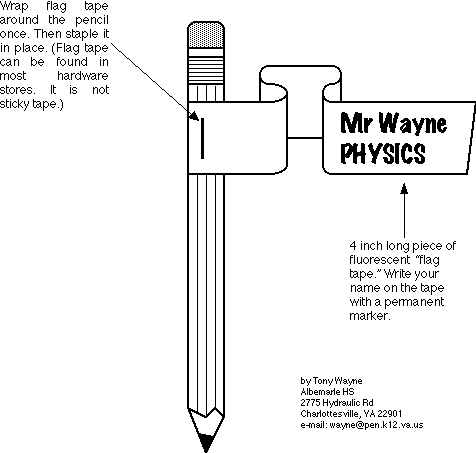

Physics Project:
Newton's Laws of Motion Boat Race Tournament
by Jeff Lawrence, Lancaster H.S., Lancaster, VA 22503,
jlawrenc@pen.kl2.va.us.
Purpose:
- ) To apply Newton's Laws of Motion, especially his third one,
to optimize the performance of a boat in terms of its thrust,
viscous(fluid) drag, guidance, velocity and distance traveled.
- ) To gain experience in the aspects of engineering, such as
conception of ideas, design, construction, testing, modification
of ideas, modification of design, modification of construction,
and completion of project.
Task:
- ) To construct a vessel which can cross a finish line(bump
into the end of the race trough 2.5 meters away or obtain a
greater distance from starting line within 45 seconds of time,
which ever comes fist.
- ) To construct a craft which can withstand the rigors of a
double elimination style tournament competition, where two boats
race at a time.
- ) Determine the maximum thrust provided by your vessel, which
includes constructing an instrument which is capable of measuring
the thrust.
- ) Minimize the resistance of the hull.
Material Constraints:
Propulsion System (provided):
- 2 - balloons. (8 provided, must be the ones used the two days
of competition, test with others)
- 2 - rubber bands. (4 provided, must be the ones used the two
days of competition, test with others)
Propulsion System (not provided):
Various materials allowed. However, paper, cardboard,
toothpicks and popsicle sticks are the only wood products allowed.
See * below.
Hull (not provided)
Various materials allowed. However, paper, cardboard,
toothpicks and popsicle sticks are the only wood products allowed.
See * below.
Materials not provided must be obtainable from a supermarket.
However, materials intended for water craft, for example, toy boats,
are not acceptable. Restrictions:
- Must be self propelled by on board propulsion system, where
the balloons and/or rubber bands provide the initial force in the
system.
- LOA (length overall) is not to exceed 4 dm.
- Beam (maximum width is not to exceed 2 dm.
- Must be self floating.
- Must be self guided.
- Vessel must start and remain in the water throughout the
race.
- Your vessel may not hinder the performance of the other
vessel.
- Your vessel may not pollute the environment.
- Others as need and practicality dictate. Hey, use common
sense.
Thrust determination: (the day before the race)
- Instrument may be attachable to race trough by means of tape
or being held.
- Time to obtain maximum thrust is 30 sec.
- Vessel is to same as will be raced.
Viscous drag test: (day before the race)
- A tow line with a loop is to be attached to a "hook" on the
vessel.
- The towing force will be provided by a falling mass. (5 - 20
g)
- Measured by time taken to travel 2.0 m.
Race Operations:
- Race ready, constructed boat is to be submitted the day before
the big race for certification, thrust testing, and viscous drag
testing.
- Bow of boat to be behind starting line until "gun".
- Boats to be restrained by contestant until "gun".
- Winner of each race decided by instructor.
- Byes and other privileges will be determined by class
standing. (In most cases.)
- Two brackets of competition:
- All begin in winners bracket, losers from winners bracket
enter losers bracket.
- Winners bracket is completed first.
- ) Survivors of each bracket will meet for the prize with the
winners bracket survivor receiving two chances to win the
prize.
Materials will not be provided so as to make modifications
Grading: Total of 150 points possible.
1.) 50 pts. for performance of vessel.
- 10 pts for timely submittal of certified vessel. Due the
day before the race.
- 10 pts EC for being in the top 10 of least resistant
vessels
- 1% of 40 pts. for each 2 cm of displacement up to 100. Day
of the race.(2.0 m is all that is necessary for the total of 40
pts. The distance of 2.5 m is for the race to advance in the
tournament so as to obtain extra credit.)
-
2.) 50 pts for well constructed thrust measuring instrument and
determination of maximum thrust. A well written analysis.
3.) 50 pts. for written analysis of your engineering required
so as to contend with Newton's three laws of motion.
- Minimum of 100 words.
- Due the day of the race.
4.) 50 pts. for written analysis of the winning vessel
according to Newton's three laws of motion. To apply data as well
as observations. What made it superior to the other craft in the
competition. Etc.
- Minimum of 100 words.
- Due the Monday following competition.
- Further addenda may follow as necessary.
Notes for the teacher:
This project seems to develop the most enthusiasm in my classes all
year. It is effective in that it requires the student to integrate
"Newton's" three law's of motion in an applied/engineering context. I
am looking for ways of making the project more quantitative, for
example, determining the maximum hull speed. This is the second yea I
have done this and the maximum thrust test and tow test quantified
the project somewhat. One of the best outcomes of this project is the
variety of craft that are produced.
Construction of the race trough
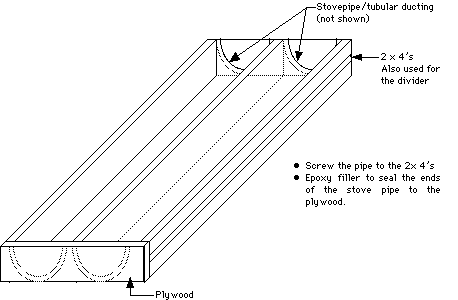
If you come up with any good improvement, modification,
implementation, or correction related to this exercise, please let me
know. Thanks.
Jeff Lawrence
Lancaster H.S., Lancaster, VA 22503
jlawrenc@?pen.kl2.va.us.
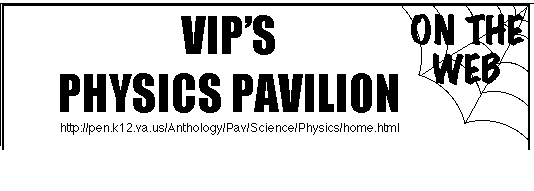
Where can you find over 100 physical science demonstrations, teaching
tips, a FREE book on teaching science in an amusement park, Virginia
SOL support list for taking amusement park trips, a set of labs for
teaching physics on the ski slopes, a starting point for web related
physics items and much, MUCH, more? At our the VIP sponsored physics
pavilion.
Below is a list of some of the available resources on the Physics
Pavilion's home page.
* Past VIP Newsletters
* Current VIP Newsletter
* Next VIP Meeting Date and Agenda (Next meeting will be in November
at the VAST conference)
* List of Education Resources
* Science Contests
* Physics and Physical Science Links
* Paramount's Kings Dominion Physics Olympics (May 16, 1997)
* Equipment Sources for Education
* Special Physics Related Libraries for Macintosh users of
ClarisWorks (NEW)
* Roller Coaster Physics resource book for educators (look for an
update by September 1 1997)
* Favorite Demo's, Labs and Amusement Park Ideas (coming soon, check
back in September)
* Roller Coaster Measurements for Paramount's Kings Dominion
* Amusement Park Science and the Virginia Standards of Learning
* Educational Opportunities for Physics and Physical Science
Teachers
* Graphing calculator software for designing simple roller
coasters
* Graphing calculator uses in physics
Tell us how we can expand and improve the site. Send your suggestions
to wayne@pen.k12.va.us
IEEE offers the
Faraday Lecture
The Institute of Electrical and Electronics Engineers (IEEE), as part
of its program for promotion of science in the public schools of our
nation, offers the Faraday lecture by satellite broadcast in February
of each year. This lecture, produced in England at a university
laboratory covers various aspects of engineering and science and is
directed at a level that approximates our K8 through 12. Because of
the difficulty of high schools scheduling for the date of the
broadcast the Central Virginia Section of IEEE is preparing to offer
a program, which includes a video tape of the broadcast along with an
instructors book, to any interested school. Also, our section expects
to provide an IEEE member to either conduct the program or simply be
available to answer questions.
We have the Faraday Lectures for the last two years. One lecture
covers the development and construction of the English Channel Tunnel
and the other covers Michael Faraday's discoveries in electromagnetic
induction. For both lectures the speakers have considerable resources
for illustration both in the lab and in the field to make an
interesting and exciting presentation. Total presentation time for
each lecture is about two hours.
We believe that in addition to flexible scheduling other advantages
such a the option of stopping the tape at any time for explanations
make the VCR tape program superior to the live broadcast. Our IEEE
section will offer this program as a public service and there will be
no charge.
If you are interested participating in this program contact Sam
Harris, 540 942-1696, Rt 2 Box 445, Waynesboro, VA 22980,
sharris@ieee.org and we will work with you on a date for the
presentation.
EDITOR
Tony Wayne, Albamarle High School, 2775 Hydraulic Road,
charlottesville, VA 22901-8916
Internet e-mail: wayne@uva386.schools.virginia.edu
PUBLISHED by
Dr. Bascom Deaver, Physics department, Universtiy of
Virginia, Charlottesville, VA 22901
PLEASE READ THIS AND RESPOND

The meeting is FREE!
If you are going To the April VIP meeting you need to fill out and
mail the form below.
Uva needs these form for 3 reasons. So they will know
(1) how many refreshments to provide
(2) name tags
(3) room size to reserve
Your Name: ______________________________
School Address: _ _____________________________
______________________________
______________________________
______________________________
_ I will be attending the VIP meeting on April 25, 1997.
_ ___ guests will be accompanying me. Please include their names and
addresses somewhere
on this form.
MAIL THIS FORM ASAP
OR send your reply via e-mail to Tony Wayne ASAP at
wayne@pen.k12.va.us
fold, staple, and add postage
- - - - - - - - - - - - - - - - - - - - - - - - - - - - - - - - - - -
- - - - - - - - - - - - - - - - - - - - - - - - - - - - - - - - - - -
- - - -
From: _______________________
DR BASCOM DEAVER
DEPARTMENT OF PHYSICS
UNIVERSTIY OF VIRGINIA
MCCORMICK ROAD
CHARLOTTESVILLE VA 22901
- - - - - - - - - - - - - - - - - - - - - - - - - - - - - - - - - - -
- - - - - - - - - - - - - - - - - - - - - - - - - - - - - - - - - - -
- - - -
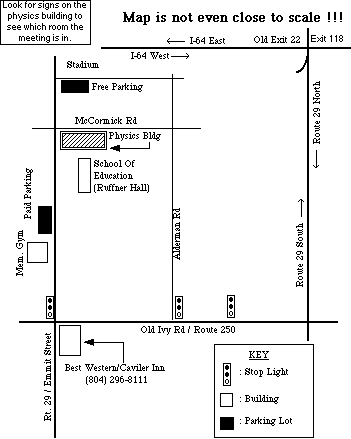
The next meeting is April 25th, 1998, at
the University of Virginia.
The meeting is free to everyone! There will be a raffle for a
commercial water rocket launcher. The launcher sold for over $100.
Okay... we got it slightly used. It was a prototype. But it looks
great! There will be many, many, many other freebies. It is worth the
trip!!!
Agenda:
9:00 -9:30 Hello's with coffee and sweets
9:30-10:30 VIP business: Elect a new president, update on the web
site, VIP furture.
10:30 -12:00 Begin sharing with other teachers.
12:00 - 1:30 Lunch (Bring your own or money to buy.)
1:30 - 3:30 More sharing. (Let us know ahead of time if you need an
overhead or anything else.
NOTES:
Come ready to share stuff.
Bring a lab or a demo to share with others. We have had some great
demo's i the past. (Bring 35 copies to share.)
The state seems to want more graphing calculator stuff -bring a
calculator tip or a lesson to share. Have you written any great
program for the graphing calculator. Bring them on disk or on your
calculator to share with everyone.
Bring a diskette of shareware that you use. We will put it up on the
web site or give it away to people who bring a blank disk.
Bring a list of resources. Just come to meet your collegues.